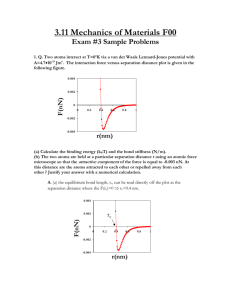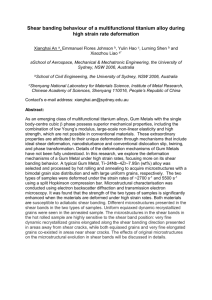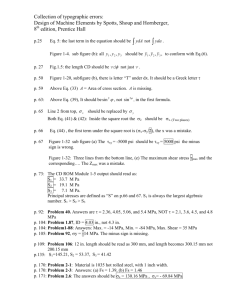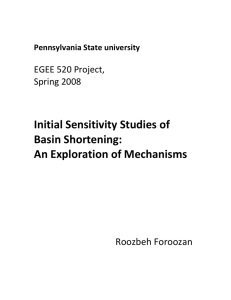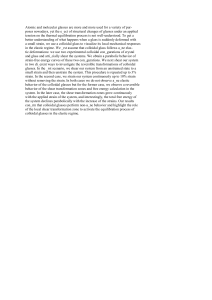Chapter 1 Tension, Compression, and Shear
advertisement
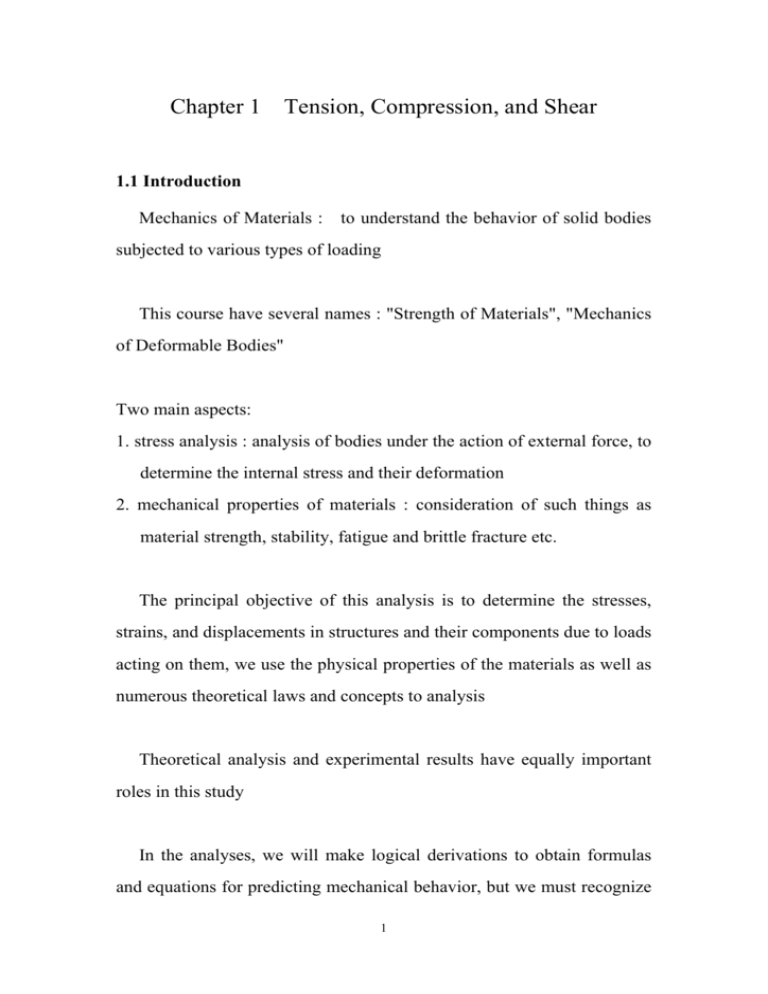
Chapter 1
Tension, Compression, and Shear
1.1 Introduction
Mechanics of Materials : to understand the behavior of solid bodies
subjected to various types of loading
This course have several names : "Strength of Materials", "Mechanics
of Deformable Bodies"
Two main aspects:
1. stress analysis : analysis of bodies under the action of external force, to
determine the internal stress and their deformation
2. mechanical properties of materials : consideration of such things as
material strength, stability, fatigue and brittle fracture etc.
The principal objective of this analysis is to determine the stresses,
strains, and displacements in structures and their components due to loads
acting on them, we use the physical properties of the materials as well as
numerous theoretical laws and concepts to analysis
Theoretical analysis and experimental results have equally important
roles in this study
In the analyses, we will make logical derivations to obtain formulas
and equations for predicting mechanical behavior, but we must recognize
1
that this formula cannot be used in a realistic way unless certain
properties of the materials are known, also, many practical problems of
great important in engineering cannot be handled efficiently by
theoretical means, experimental measurements becomes a necessity.
In the study of this course, you will find that your efforts are divided
naturally into two parts
1. understanding the logical development of the concepts
2. applying those concepts to practical situations
Finally, sometime use the symbolic solution, it provides the
opportunity to check the dimensions at any stage of the work, and the
most important reason is to obtain a general formula that can be
programmed on a computer
Both systems of unit are used
1. International System of Units (SI unit) : basic units are kg, sec, m
2. U.S. Customary System (USCS) : basic units are lb, sec, ft
Relative Courses:
Statics (Dynamics) --> Mechanics of Materials --> Advanced
Mechanics of Materials --> Elasticity --> Plasticity, Viscoelasticity,
Structural Stability, Plate and Shell, Experimental Stress Analysis etc.
1.2 Normal Stress and Strain
2
Consider a prismatic bar, the axial forces produce a uniform stretching
of the bar, it is called the bar is in tension
mn : cross section z
the
longitudinal axis
A : cross section area
the intensity of the force (force per unit area) is called stress, assuming
that the stress has uniform distribution, then
=
P
C
A
force equilibrium
when the bar is stretched, the resulting stress are tensile stress, if the
bar is compressed, the stress are compressive stress
the stress
acts in the direction perpendicular to the cut surface, it
is referred as normal stress, another type of stress is called shear stress
sign convention of the normal stresses are : tensile stress as positive
and compressive stress as negative
Unit of stress :
SI unit : N / m2 (Pa, Pascal),
1 MPa =
USCS :
106 Pa,
N / mm2 (MPa)
1 GPa
lb / in2 (psi), kip / in2 (ksi)
1 psi = 6,895 Pa
= 109 Pa
1 ksi = 103 psi
1 ksi = 6.895 MPa
3
for a force
P = 27 kN
acts on a round bar with
d = 50 mm,
the
stress is
=
P
C
A
=
The equation
P
CCC
d2/4
=
27 kN
= CCCCCC
(50 mm)2/4
P/A
=
13.8 MPa
to be valid only for the stress must be
uniformly distributed over the cross section of the bar, this condition is
realized if the axial force P
acts through the centroid of the cross
section
the uniform stress condition exists throughout the length of the
member except near the ends (end effect or Saint Venant's principle)
if the load itself is distributed uniformly over the end, the stress at the
end is the same as elsewhere, for the concentrated load acts at the end
(over a small area), resulting in high localized stressed and nonuniform
stress distribution
the formula
= P/A
point that is at least a distant
may be used with good accuracy at any
d
away from the end, where
d
is the
largest transverse dimension of the bar
the formula
= P / A is the average normal stress when the
stress distribution is nonuniform
4
An axial load bar becoming longer when in tension and shorter when
in compression
the elongation
is the cumulative of the stretching throughout the
length L of the bar, then the elongation per unit length is called strain
= C
L
(normal strain : associated with normal stress)
tensile strain : positive
compressive strain : negative
strain is a dimensionless quantity, it is recorded in the form as
mm/m,
m/m, in/in
e.g. L
then
=
2 m,
= 1.4 mm
1.4 x 10-3 m
= CCCCC = 0.0007 = 0.7 mm/m
2m
= 700 x 10-6 = 700 m/m = 0.07%
Uniaxial Stress and Strain
for a prismatic bar, the loads act through the centroid of the cross
sections, and the material be homogeneous, the resulting state of stress
and strain is called uniaxial stress and strain
5
Line of Action of the Axial Forces for a Uniform Stress Distribution
consider a prismatic bar of arbitrary cross-sectional shape subjected to
axial forces
P
that produce uniformly distributed stresses
,
let
p1(x, y) represent the point in the cross section where the line of action of
the forces intersects the
cross section
the moments of the force
Mx
_
Py
=
My
P
are
_
= -Px
for an element of area dA,
on the element is
the
x and
the force acts
dA, and the moments of this elemental force about
y axes are
y dA
and
-
x dA, the total moments
are obtained by integrating over the cross sectional area
Mx
∫ y dA
=
_
Py =
then
because the stress
_
y =
My =
- ∫ x dA
_
P x = ∫ x dA
∫ y dA
is uniformly distributed,
∫y dA / A
and
_
x =
= P / A, then
∫x dA / A
these equations are the same as the equations of the centroid of and
area, thus we and concluded that : in order to have uniform tension or
compression in a prismatic bar, the axial force must act through the
centroid of the cross-sectional area
Example 1-1
for a hollow circular tube of aluminum supports a compressive load of
6
240 kN, with d1 = 90 mm and d2 = 130 mm, its length is 1 m, the
shortening of the tube is 0.55 mm, determine the stress and strain
C (d22 - d12) = C (1302 - 902) = 6,912 mm2
4
4
A =
P
= C
A
=
240,000 N
CCCCC
6,912 mm2
= 34.7 MPa (comp.)
the compressive strain is
= C
L
=
0.55 mm
CCCC =
1,000 mm
550 x 10-6
=
550
m/m
Example 1-2
a circular steel rod of length L
a weight
W
(a) find
max
and diameter d
hangs and holds
at its lower end
of the rod, included its own weight
(b) L = 40 m, d = 8 mm, W = 1.5 kN, calculate
(a) the maximum force
Fmax
Fmax
=
W + W0
max
=
Fmax
CC
A
occurs at the upper end
= W+ V =
W+ AL
= CCCCC
A
(b) the weight density
max
W+ AL
W
= C
A
of steel is
+
L
77 kN/m3, the maximum
stress is
max
=
1,500 N
CCCCCC
(8 mm)2 / 4
+
=
29.84 MPa
3.08 MPa
+
7
(77 kN/m3) (40 m)
=
32.92 MPa
1.3 Mechanical Properties of Materials
mechanical properties of materials used in engineering design are
determined by tests of small specimen according standards
ASTM : American Society for Testing of Materials
JIS : Japanese Industrial Standards
CNS : Chinese National Standards
etc.
the most common test is tension test for metals, to obtain the
stress-strain diagram of materials (compression test are most used for
rock and concrete)
cylindrical specimen are used
ASTM standard specimen for tension test (round bar)
d
=
0.5 in (12.7 mm)
GL = 2.0 in (50 mm)
when the specimen is mounted on a testing system (MTS, Instron etc.),
the load
P
and the elongation between
simultaneously
static test : the load is applied very slowly
dynamic test : load rate is very high
8
GL
are measured
in the test
= P/A
=
A : initial area of the cross section
/ GL
: nominal stress (engineering stress)
: nominal strain (engineering strain)
t
: true stress (use actual area of the bar)
t
: true strain (actual distance of GL is used)
(∵ during test, A and GL may vary)
specimens for compression test
cubic : 2.0 in (50 mm) on one side
cylinder : d = 1 in (25 mm), L = 1 ~ 12 in (25 ~ 305 mm)
concrete : d = 6 in (152 mm), L = 12 in (305 mm), 28 days old
stress-strain diagram is characteristic of material
for mild-steel (low carbon steel)
A :
proportional limit (210 ~ 350 MPa, 30 ~ 50 ksi)
9
B : yield stress (more than 550 MPa [80 ksi], depends on the carbon
content)
D : ultimate stress
E : fracture
OA : linear region
BC : perfect plasticity
CD : strain hardening
DE : necking
definitions of yield stress
om : specified offset, commonly 0.2 %
om : specified extension under load, commonly take 0.5%
lateral contraction occurs when specimen is in stretched, decrease in
cross-sectional area
for small strain,
(A < A0)
j
t,
for large strain,
<
t
when contraction become large, necking occurs
in the stress-strain diagram
engineering - curve have a ultimate point D, and then decrease, this
10
decrease is due to necking of the bar
in true - curve, no decrease occur
definition of true strain : after a load
the length changes from
L0
to
P is applied to the specimen,
L,
produces an incremental length change
an additional load
dL,
the strain
de
dP
due to
this increment is
d
t
=
dL
CC
L
where L
therefore, true strain
is current length
can be expressed as an integral of the strain
t
increment
L
t
= ∫
L0
but
∴
L
C =
L0
t
=
dL
CC
L
1
L
= ln C
L0
+
ln (1 + )
for small strain
t
j
definition of true stress
t
= P/A
where A is current area, note that
A g
A0
assume that under certain conditions of the volume of the material is
the same before and after loading (it is true in plastic range)
A0 L0
or
L
C
L0
=
=
AL
A0
C =
A
1
+
11
P
= C
A
=
also for small strain
t
∴
t
with known
-
P A0
CC =
A0 A
(1 + )
=
curve,
t
-
t
curve can be obtained
Materials that undergo large strains before failure are classified as
ductile ( f > 10%), such as mild steel, aluminum and its alloy, copper,
lead etc.
aluminum alloy do not have a clearly
definable yield point, gradual transition
from linear to nonlinear region, yield stress
always determined by offset method, in
general, use 0.2% offset, it should be
referred as offset yield stress, it is slightly
above the proportional limit
The ductility of material in tension can be characterized by its
elongation and by the reduction area
Lf - L 0
percent elongation = CCC x 100%
L0
12
Lf : distance between gage mark in fracture
∵ the elongation is concentrated in the region of necking, thus the
percent elongation depends upon the gage length and the dimensions of
the specimen, when use percent elongation, the gage length should be
given
percent reduction in area
=
A0 – Af
CCC x 100%
A0
(RA)
Af : final area at fracture section
for ductile steel, RA j
50%
For material have small fracture strain, it is
classified as brittle material, such as concrete, cast
iron, rock, glass, etc.
B : fracture stress, same as ultimate stress
Stress-Strain diagram in compression have different shapes from those
in tension, its cross-sectional will increase after yielding, and no necking
occur
13
1.4 Elasticity, Plasticity and Creep
(a) linear elastic
(b) nonlinear elastic
(c) elastoplastic
unloading is elastic
most of metallic materials have
behave in this type
for reloading, the yield stress is
increased to
B
(d) creep
(e) relaxation
other properties : fatigue strength, toughness, fracture toughness,
notch toughness, resilience, etc.
14
1.5 Linear Elasticity, Hooke's Law and Poisson's Ratio
behavior of materials : linear and elastic
homogeneous : same composition throughout the body
isotropic : same elastic properties in all direction
linear relationship between stress and strain for linear elastic
homogeneous and isotropic materials
= E
(Hooke's Law)
E : modulus of elasticity (Young's modulus)
for steel
E =
190 ~ 210 GPa
or 28,000 ~ 30,000 ksi
for Al
E =
70 ~ 73 GPa
or 10,000 ~ 10,600 ksi
the value of E
for most materials are listed in Appendix H
Poisson's ratio : when a bar is loaded in tension, the axial elongation is
accompanied by lateral contraction, the lateral strain is proportional to the
axial strain in linear elastic range for homogeneous and isotropic
materials, the Poisson's ratio
=
lateral strain
- CCCCCC
axial strain
is defined
=
'
-C
' : lateral strain
has a positive value for ordinary materials, and equal 0.25 ~ 0.35
for most materials, and it has almost the same value for both tension and
compression
15
Example 1-3
A steel pipe with
P = 620 kN,
L = 1.2 m, d2 = 150 mm, d1 = 110 mm
E = 200 GPa,
= 0.3
determine (a) , (b) ', (c) <d2 and <d1
(d) <t
(d22 - d12) / 4 =
A=
=
(1502 - 1102) / 4 = 8,168 mm2
= - 620 kN / 8,168 mm2 = - 75.9 PMa (comp)
-P/A
=
/E =
(a)
=
L
(b)
' = -
- 75.9 MPa / 200,000 MPa
(- 379.5 x 10-6) (1,200 mm)
=
= - (0.3) (-379.5 x 10-6)
=
=
=
- 0.455 mm
113.9 x 10-6
(c) <d2
=
' d2
=
(113.9 x 10-6) (150 mm)
=
0.0171 mm
<d1
=
' d1
=
(113.9 x 10-6) (110 mm)
=
0.0125 mm
(d) <t
=
't
=
(113.2 x 10-6) (0.75in) = 0.000085 in
1.6 Shear Stress and Strain
shear stress : parallel or tangent to the surface
e.g.
bearing stress : contact stress between clevis and bolt
1
- 379.5 x 10-6
the average bearing stress
b
b
is
= Fb / Ab
16
Fb : bearing force
the shear force
V
Ab : bearing area
= P/2
the shear stress distributed over the cross sectional area of the bolt, the
exact shear stress distribution is not known yet, it is highest near the
middle and become zero on the edge, the average shear stress is
ave
=
V/A
direct shear (simple shear) : shear stresses are created by a direct
action of the force in trying to cut through the material, such as of bolts,
pins, rivets, keys, etc.
shear stresses also arise in an indirect manner when members are
subjected to tension, torsion and bending etc.
double shear : in the above example, there are two planes to subject
shear force
single shear : only one plane to subject shear force
consider a small element having sides of lengths a, b, and c
x, y, and z directions, respectively
17
in the
applied at the top and also at the bottom
(force equilibrium)
applied at the top and also at the right surface
(moment
equilibrium)
( a c) b
=
( b c) a
moment about z-axis
shear stress has the properties :
1. shear stresses on opposite faces of an element are equal in
magnitude and opposite in direction
2. shear stresses on perpendicular faces of and element is equal in
magnitude and have directions such that both stresses point toward or
away from the corner
an element subjected to shear stress only is said to be pure shear, and
the material will deform, resulting in shear strains
the angle
is a measure of the distortion, it is called shear strain,
its unit are in degrees or radians
Sign convention of shear stress :
positive surface : out normal directed in the positive direction
shear stress acting on a positive face is positive if it is acts in the
positive direction of the coordinate axis, and negative if it acts in the
negative direction of the axis
18
Sign convention for shear strain :
shear strain is positive when the angle between two positive (or
negative) faces is reduced, it is negative when the angle between two
positive (or negative) faces is increased
Hooke's Law in Shear
from experimental result, shear stress-strain diagram may be plotted
y
j
0.5 ~ 0.6
y
in the linear elastic region
=
G
G : shear modulus of elasticity (modulus of rigidity)
G have the same unit as E
G =
75 ~ 80 GPa
= 26 ~ 28 GPa
E,
or
or
10,800 ~ 11,800 ksi
3,800 ~ 4,300 ksi for Al and its alloy
,
G
are not independent, they are related by
G
=
E
CCCC
2 (1 + )
this relation will derived in chapter 3
∵
=
0 ~ 0.5
for steel
∴ G =
19
(2 ~ a) E
Example 1-4
A punch for making hole
punch diameter d
plate thickness t
punching force
=
=
P
=
20 mm
800
110 kN
(a) average shear stress in the plate
the shear area
As is
As
=
=
dt
P
C =
As
=
aver
(20 mm) (8 mm)
110 kN
CCCCC
=
502.7 mm2
= 502.7 mm2
219 MPa
(b) average compressive stress in the punch
=
c
P
CCC
Apunch
P
= CCC
d2/ 4
=
110 kN
CCCCC
=
2
(20 mm) /4
350 MPa
Example 1-5
A steel strut S serving as a grace for a bolt
P =
54 kN
wall thickness t
= 40o
angle
=
12 mm
dpin = 18 mm
gussets thickness tG = 15 mm
base plate thickness tB = 8 mm
dbolt = 12 mm
(a) bearing stress between strut and pin
b1
=
1
P
54 kN
C CC = CCCCCCCC
2 t dpin
2 (12 mm) (18 mm)
20
=
125 MPa
(b) shear stress in pin
=
pin
1
P
C CCCC
2
d2pin/ 4
=
54 kN
CCCCCCC
2 (18 mm)2 / 4
= 106 MPa
(c) bearing stress between pin and gussets
=
b2
1
P
C CCC
2 tG dpin
=
54 kN
CCCCCCCC
2 (15 mm) (18 mm)
=
100 MPa
(d) bearing stress between anchor bolts and base plate
=
b3
1 P cos 40o
C CCCC =
4
tB dbolt
(54 kN) cos 40o
CCCCCCCC
4 (8 mm) (12 mm)
= 108 MPa
(e) shear stress in anchor bolts
=
bolt
1 P cos 40o
C CCCC
=
4
d2bolt/ 4
(54 kN) cos 40o
CCCCCCC
=
4 (12 mm)2 / 4
91.4 MPa
Example 1-6
a elastomer of linear elastic material
capped by a steel plate
thickness of elastomer is
h
dimension of the plate is
axb
subjected to a shear force
ave
d
=
V
V
CC
ab
= h tan
=
=
ave
CC
Ge
=
V
CCC
a b Ge
V
h tan(CCC)
a b Ge
in most practical situations the shear strain
21
is very small, and is
such cases we replace
d
= h
=
tan
by
and obtain
hV
CCC
a b Ge
1.7 Allowable Stresses and Allowable Loads
Strength : the ability of structure (or material) to resist loads
The actual strength of a structure (or material) must exceeded the
required strength
Factor of Safety n
n ≧
1
n
actual strength
CCCCCCC
required strength
=
=
1 ~ 10
Failure : fracture or complete collapse of structure or deformations
have exceeded some limiting value
the determination of a factor of safety must also take into account such
matter as follows :
‧the accidental overloading
‧ the type of load (static, dynamic or repeated)
‧ possibility of fatigue failure
‧ inaccuracies in construction, quality of workmanship
‧ variation in properties of materials
‧ environmental effect (corrosion, thermal effect, etc.)
‧ accuracy of method of analysis
‧ failure is gradual or sudden
22
‧ others
if factor of safety too low, probability of failure will be high, if too
high, waste materials
for many structure, it is important that the material remain within the
linear elastic region, in order to avoid the permanent deformation, use
yield stress and factor of safety to design, this is called allowable stress
(or working stress)
allow
yield stress
= CCCCCCC
factor of safety
nowhere of the structure yields, for tension and shear stresses
y
allow
y
= CC
n1
allow
e.g. for building design, n
takes
= CC
n2
1.67 for mild steel
another method, use the ultimate stress instead of yield stress, this
method is suitable for brittle materials, the allowable for tension and
shear stresses are
u
allow
u
= CC
n3
allow
= CC
n4
n is normally much greater then that when use
e.g. n = 2.8 for mild steel
in aircraft design, use margin of safety
margin of safety
= n-1
23
y,
Allowable load concept is also used in design
Allowable load
=
(Allowable stress) (Area)
Pallow =
allow
A
for tension
Pallow =
allow
A
for shear
Pallow =
b
Ab
for bearing
another method, use the service loads (working loads) and factor of
safety to determine the ultimate loads
factor of safety
or
ultimate load
CCCCCC
service load
=
ultimate load = service load x load factor (factor of safety)
this is known as strength design or ultimate load design
e.g. for reinforced concrete structure
load factor = {
1.4
for dead load
1.7
for live load
Example 1-7
a steel bar serving as a vertical hanger
b1 = 38 mm
t = 13 mm
b2 = 75 mm
d = 25 mm
determine the allowable load P
(a)
allow
P1
= 110 MPa in the main part
=
allow
A =
allow
b1 t
24
(b)
allow
P2
=
(110 MPa) (38 mm x 13 mm)
=
53.4 kN
= 75 MPa
=
=
in the hanger at the cross section through the bolt
allow
A =
allow
(b2 - d) t
(75 MPa) (75 mm – 25 mm) (13 mm)
= 48.7 kN
(c) ( b)allow = 180 MPa between hanger and bolt
P3
=
=
(d)
allow
P4
b
Ab
=
b
dt
= (180 MPa) (25 mm) (13 mm)
58.5 kN
= 45 MPa
=
=
allow
for the bolt
A =
allow
2 ( d2) / 4 = (45 MPa) 2
(25 mm)2 / 4
44.1 kN
comparing the four preceding results
Pallow
= minimum [P1, P2, P3, P4] = 44.1 kN
failure by shear on the bolt first
1.8 Design for Axial Loads and Direct Shear
Design : to determine the properties of the structure in order that the
structure will support the loads
Required area
=
Load to be transmitted
CCCCCCCCCC
Allowable stress
analysis : the calculation of such quantities as stresses, strains, and
deformations of loaded members or structures
25
design : the determination of the geometric configuration of a structure
in order that it will fulfill a prescribed function
optimization is the task of designing the "best" structure to meet a
particular goal, such as least weight
analysis, design and optimization are closely linked
Example 1-8
a two-bar truss ABC as shown
allow
for AB is
allow
for pin
C is
125 MPa
45 MPa
determine AAB and dC
MC = 0
for the whole structure
RAH x 2 - 2.7 x 0.8 - 2.7 x 2.6 = 0
Fx
RAH
=
=
0
RCH
MB = 0
=
4.59 kN
for the whole structure
RAH
=
4.59 kN
for the member
BC
- RCV x 3 + 2.7 x 2.2 + 2.7 x 0.4 = 0
Fy
RCV
=
2.34 kN
=
0
for the whole structure
RAV + RCV - 2.7 - 2.7 = 0
RAV
=
3.06 kN
26
FAB
VC
=
=
RA
(R AH ) 2 + (R AV ) 2 =
=
RC =
(R CH ) 2 + (R CV ) 2 =
the required area for member
AAB
=
FAB
CC
5.152 kN
AB is
5.516 kN
= CCCC =
allow
5.516 kN
44.1 mm2
125 MPa
the required area for pin C (double shear) is
AC
=
dpin =
VC
CCC
2 allow
4 Apin π
5.152 kN
= CCCCC
2 (45 MPa)
=
8.54 mm
27
=
57.2 mm2

